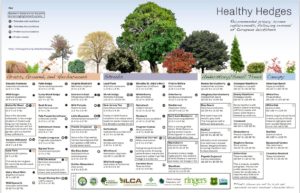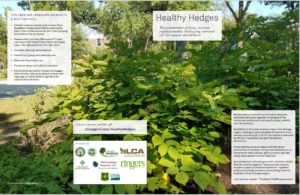Loch Lomond Garden club started earlier this year as a way to share education our residents have with each other. We meet monthly on the first Wednesday of the Month.
Last month we had the pleasure of Meeting Arlene Doran, Lomond Drive. She talked about all of the plants she had growing in her backyard. She also helps with the plants at South Beach. What is so special about South Beach? It is a tried place for Loch Lomond native plants for buffer strips.
What is a Buffer Strip and why Native Plants?
A Buffer Strip is an area of land with vegetation which helps control Water Quality, Soil Quality and Air Quality. Buffer Strips filter nutrients and pesticides we don’t want to get into the lake.
Some reasons for Native gardens: They provide food and habitat for birds and pollinators, manage storm water, thrive without extra watering once established, and remove extra carbon and pollutants from the air. In fact 1 acre of native plants sequesters 3,000 lbs of carbon. One goal for a native plant area is to have something for pollinators from Spring through Fall.
Also, native plants along the shoreline and in the water reduce algae blooms by removing excess nutrients. This can help reduce algae blooms. Nitrogen and extra fertilizer applied to lawns runs off and feeds the algae in the water. Lake residents can also help by skipping lawn fertilizer.
Let’s start with plants which work well around Loch Lomond Shoreline and are a Spring bloomer.
Golden Alexander – (Zizia aurea) Only two feet tall and covered with yellow umbrels in Spring. It forms colonies in moist conditions and grows in sun to part shade. It is the host plant of the Black Swallowtail butterfly.
What is a host plant? Butterflies can get nectar from any flower that makes it, but most are very picky about where they lay their eggs. That’s a host plant. No host plants, no butterflies!
Next up, an iris that likes wet feet, and blooms in early Summer
Blue Flag Iris – (Iris virginica shrevei) I have to include this beautiful iris. I have had it along my shore for almost twenty years. However, I should say there are years when the muskrats are bad, and I don’t see a single bloom, but there are the good years, and to me they are worth having.
Blue Flag Iris blooms late Spring to Early Summer. They are 2 – 3’ tall and need quite a bit of Sun and very moist conditions.
As Summer progresses, two closely related natives come into bloom.
Blue False Indigo – (Baptisia australis) Stunning spikes of blue flowers and a plant that looks like a shrub with lovely bluish-green foliage. Bloom time is June – July and it can get 5’ tall. It is not right at the water’s edge. It likes a medium amount of moisture and lots of sun. It takes a few years to get established, as it first needs to get a taproot going.
White False Indigo – (Baptisia alba) This one looks like asparagus in early Spring, and then transforms into a fabulous 5’ perennial with dramatic spikes of white blooms. This is a very large plant that is worth every inch. It also requires patience as it may take up to four years to develop and produce flowers. Bloom time is June-July.
Now it is late summer, and time for a milkweed to get the spotlight
Rose or Swamp Milkweed – (Asclepias incarnata) This is an unusually attractive and elegant plant, that is what IL Wildflowers says, and I can’t disagree. This milkweed likes moisture, try it right on the shore or other wet location, with full sun to a little shade. It has striking rose colored blooms. Size ranges from 2’ all the way up to 6’. It is not as aggressive as common milkweed. It is a host for the monarch butterfly, so you can do a little bit to save an endangered species and add something beautiful to your property.
This one is hard to miss when it is blooming at South Beach.
Swamp Rose Mallow – (Hibiscus moscheutos) It is hard to believe this tropical looking flower is a native, but it is. Swamp Rose Mallow ranges in height from 3’ to 7’ with spectacular pink hibiscus blooms from mid-summer to fall. This plant needs consistent moisture and is happy with wet feet and sunshine to part shade.
Another late summer bloomer that can be a little aggressive
Obedient Plant – (Physostegia virginiana) Spikes of lavender blooms on plants up to 4’ tall. This one is for the back of the buffer strip as it likes moderate moisture in full or partial sun. Bees love it, but because it is in the mint family, bunnies do not…. Did I say it can be aggressive?
Fall means Asters.
New England Aster– (Symphyotrichum novae-angliae) It is hard not to like this aster’s beautiful pop of bright purple petals and golden eyes. The individual florets are small, but they are produced in masses. Bees flock to this as a fall food source and I have seen monarchs on it too. It grows up to 4’ tall and can take moist to medium soil conditions in sun or part shade. If conditions are too dry for its liking the stems will turn brown and lower leaves will drop. This can be a problem if it is in front of a buffer strip.
One of the best things about gardening is the good surprises, and I am ending this list with a wonderful plant that just showed up at South Beach a few years ago.
Sneezeweed – (Helenium autumnale) Great plant, terrible name, it doesn’t cause sneezing or hay fever. It grows 3’ to 5’ tall with cheerful yellow daisy-like flowers. It likes to be along water in moist conditions in full-part sun. This is another fall bloomer, probably the latest bloom time at South Beach.
Where are the grasses and sedges? While a few different grasses were planted at South Beach, none of them thrived there for very long. I have Indian grass, Switchgrass and lots of Northern Sea Oats, but not in buffer strip applications.
We need an intrepid gardener to try some native grasses so this list can be expanded. If you are interested in learning more or sharing your knowledge, please join the garden club. Next meeting is October 5th at 6pm. 277 Banbury Rd.
Special thanks to our residents, Arlene and Jane, for their help putting this information together.
Additional information regarding healthy hedges can be found here: healthyhedges


